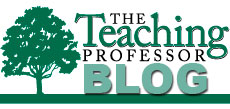We need to work more with students on seeing exams as something more than just grade generating experiences. Exams can be powerful encounters through which students learn course content and learn about learning. However, given the importance placed on grades, I’m not terribly optimistic about a lot of students discovering on their own what can be learned from an exam experience. We need to frame exams with a stronger focus on learning, and here’s a great example.
 It’s a postexam review activity originally used in an introductory biology course where the exams were mostly multiple choice. The activity includes these components:
It’s a postexam review activity originally used in an introductory biology course where the exams were mostly multiple choice. The activity includes these components:
- Correcting and Reflecting – With their graded exam returned, students were charged with providing the correct answer for each question missed and identifying the sources they used to correct the answer. Next, they had to explain why their original answer was incorrect. And finally, they had to tell why they missed the question. They did this by selecting from a list of possible reasons—such as misread the question, used incorrect logic, didn’t know enough information—or providing an alternative explanation if their reason wasn’t listed.
- Examining Study Strategies and Behaviors – This component included a list of 16 study tools (e.g. flash cards and concept maps) and behaviors (e.g. regular class attendance and study times). Here students indicated the tools and actions they used to prepare for the exam and which ones they found most helpful.
- Using Open–ended Reflection – Finally, students responded to a three-part question: 1) was the grade an accurate reflection of what they knew for the exam and how well prepared they felt; 2) what could they do to improve their learning prior to the next exam; and 3) what could the instructor do to improve their learning experience.
Students had one week after the exam to complete this assignment. It was worth up to 10 points with the exam worth 100 points. Students did the assignment after each of the three major exams, although the structure changed for Exams 2 and 3 to give students more flexibility in their analysis.
What makes this activity especially interesting is the analysis of the assignment undertaken by faculty and students (two are listed as first authors of this piece). It’s reported in this reference and in a larger follow-up study highlighted in the May issue of the Teaching Professor newsletter. The sample size in this first analysis was small, even so the results raise some interesting questions. Not surprisingly, students were able to correct their answers. But when they tried to explain why their incorrect answers couldn’t be right, only 62% of their responses received a “High Quality” score, using a rubric developed for the analysis. The authors make two points here: students may be able to correct answers and still not understand the material in the exam question; and this discrepancy “underscores a common limitation of multiple-choice questions to accurately assess student understanding.” (p. 87)
Students in this sample were also convinced they were using the best methods to prepare for the exam. They relied heavily on materials provided by the instructor—study worksheets and a prelecture assignment. Any study approach that required motivation and self-direction, such as self-testing, regular study of the content, reading before attending lecture, were used significantly less often and only 11% believed approaches like these held much value, even though the effectiveness of these more self-directed strategies is widely supported by research.
Also, perhaps not surprising, almost half the students didn’t feel their grade on Exam 1 reflected what they knew, and they regularly attributed that discrepancy to careless mistakes. “This suggests that they [students] believe using caution is the only measure they need to take to improve their performance on future exams.” (p. 90)
Yes, this is a labor-intensive assignment, for teachers and students. Something the authors readily agree. But as the follow-up study reveals, it’s an assignment that contributed to improved exam scores and promoted metacognitive development. Students learn the content and they learn more about learning the content. That’s a big payoff, and assignments like this don’t need to occur in every course. We need to think more strategically about where assignments (of various sorts) should be placed within a curricular experience.
References: Andaya, G., Hrabak, V., Reyes, S., Diaz, R. and McDonald, K. (2017). Examining the effectiveness of a postexam review activity to promote self-regulation in introductory biology students. Journal of College Science Teaching, 46 (4), 84-92.
Dang, N., Chiang, J., Brown, H., and McDonald, K. (2018). Curricular activities that promote cognitive skills impact lower-performing students in an introductory biology course. Journal of Microbiology and Biology Education, 19 (1), 1-9.






